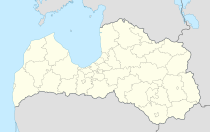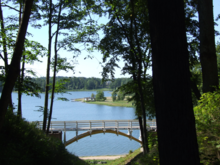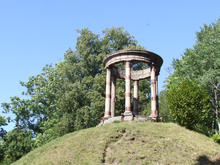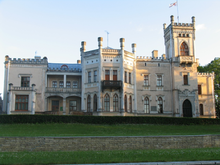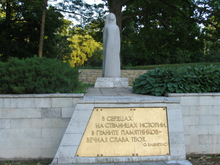Alūksne
| Alūksne ( German : Marienburg) | ||
|---|---|---|
 |
|
|
| Basic data | ||
| State : |
|
|
| Landscape: | Livonia ( Latvian : Vidzeme ) | |
| Administrative district : | Alūksnes novads | |
| Coordinates : | 57 ° 25 ' N , 27 ° 3' E | |
| Residents : | 7,982 (Jan 1, 2016) | |
| Area : | 14.2 km² | |
| Population density : | 562 inhabitants per km² | |
| Height : | 206 m | |
| City law: | since 1920 | |
| Website: | www.aluksne.lv | |
| Post Code: | ||
| ISO code: | ||
Alūksne ( German : Marienburg ) is a city in northeast Latvia on the Alūksner plateau (previously: Marienburger plateau). The mean altitude of the place is about 200 m above sea level . Alūksne received city rights in 1920. Alūksne is the center of the district of the same name.
"Alust" or "Volust" is mentioned as early as 1284, as can be seen from the 1st and 2nd Pskovsk Chronicles. The later place names is the Latgale "olūksna" ( spring in the forest returned).
Waters
Alūksne is located on the 15.7 km² Alūksne Lake ( Alūksnes ezers ), the eleventh largest in Latvia. The lake is located at a height of 183.7 meters above sea level . An approximately 800 meter long peninsula with the Alūksne cemetery protrudes into the lake. There are also four islands: Cepurīte ("Little Hat"), Garā ("Long Island"), Tīklu ("Net Island") and Marijas sala (" Mary Island") , which is also called Pilssala ("Castle Island"). The castle island is the largest of the four islands with about 10 hectares and can be reached from the city via a wooden bridge. The lake is known for its abundance of fish.
Marienburg
In 1342, the Livonian order master Burchard von Dreileben built the stone Marienburg on Marieninsel. The German knights of the order gave this castle the name "Marienburg". The first commander was Arnold von Vietinghoff , who initiated the settlement of locals around the lake.
The place developed over time as the square has an excellent location along various connecting routes towards Estonia and Russia . In the course of history the castle and the place were conquered alternately by Germans, Russians, Poles and Swedes .
In 1658 Marienburg was occupied by Russian troops. At Easter 1661, Emperor Leopold I's envoy , Baron Augustin von Meierberg, interrupted his journey to Moscow with his entourage . A painting depicting the castle was preserved from this stay.
During the Great Northern War the castle was occupied by Swedes in 1702 and was blown up because the Swedes under Captain Wolff did not want to leave the fortress to the Russians.
The residents of the castle and those seeking protection were taken as prisoners by the Russians. Among them was Johann Ernst Fortunately , the Bible translator and his maid, Marta Skavronska, the later Russian Empress Catherine I .
Nowadays the castle ruins offer an open-air stage with 3000 seats.
Temple mount
In 1807, a temple of fame was erected in the southwest of the cemetery peninsula on Lake Alūksner in honor of the Swedish captain Wolff and the Russian field marshal Sheremetyev . The two had faced each other here in the Great Northern War about a hundred years earlier.
According to a legend, the warriors are said to have carried earth in their caps at this point and piled it up in order to have a better field of fire and a better view of the lake and the castle.
On the occasion of this legend and to stimulate tourism, various objects were erected in the 1930s, such as the Sun Bridge at the foot of the Temple Mount, which was built in 1938 and restored in 1995.
New lock
The "New Castle" of Marienburg was built from 1859 to 1863 in neo-Gothic style at the instigation of Alexander von Vietinghoff . The castle front with its polygonal hall faces north to the terraces in the direction of Lake Alūksner.
In 1924 the castle was requisitioned by the 7th Sigulda Infantry Regiment . The rooms are now used by the Museum of Cultural Heritage, the Art Museum, the Nature Museum, a cinema, a children's and youth center and the ceramics faculty of the Alūksner Art School.
After the Second World War, a memorial for the fallen Soviet soldiers was erected on the terraces in front of the palace , which was expanded to include the memory of those who fell in both world wars after Latvia regained independence.
Castle Park
Around the New Palace is the palace park, which goes back to the initiative of Burchard von Vietinghoff , the son of Otto Hermann von Vietinghoff . The park was created as a romantic park in the second half of the 18th century . In its time it was considered the most beautiful park in Livonia (Latvian: Vidzeme ). Today it is still one of the most interesting dendrological parks in the Baltic States . The park is a landscape with a lake, a small pond, bridges, hills, forest and places for views and views as well as with the pavilion of the winds, the mausoleum , the obelisk in honor of Otto Hermann von Vietinghoff and the wooden Alexander pavilion.
Lucky oaks
After the German pastor Ernst Glück settled in Marienburg in 1683 , he founded the first school for Latvian peasant children here. He learned the language and translated the Bible from the original languages into Latvian . After completing the translation of the New Testament in 1685 and the translation of the Old Testament in 1689, he planted an oak each. The square with the two oaks is used every year as an event location for commemorations in honor of Ernst Glück.
In the immediate vicinity of these oaks, Glück lived with his family and the maid Martha Skawronska . In 1702, during the Great Northern War, Glück fell into Russian captivity and was taken to Moscow with his family and the maid. Martha first became the lover of Prince Alexander Menshikov , a good friend of Peter the Great and later his own lover. From 1724 she was his co-regent and went down in history as Tsarina Katharina I after Peter's death in 1725 . Ernst Glück became the rector of the first Moscow high school in Moscow and translated the Bible into Russian for his students.
Bible Museum
To commemorate the Bible translations by Ernst Glück , a Bible museum was set up in Alūksne. The building erected in 1908 carries the features of the buildings at Pillnitz Castle . Originally built as a sales facility , the building was later used as a pub . After that it belonged to the castle for some time as a secondary room and later to the church. In 1940 the house - like the church - was spared from a city fire. The Bible Museum has been here since November 18, 1990. It contains finds and memorabilia from Ernst Glück's holdings as well as a facsimile of the 1694 translation of the Bible in Old Latvian.
Lutheran Church
Between 1781 and 1788 Otto Hermann von Vietinghoff built a Lutheran church in Marienburg based on plans by the architect Christoph Haberland . The church, built in the classical style, has a 55.5 m high tower. The church houses an exhibition of paintings and a copy of the original translation of the Bible by Ernst Glück.
Narrow gauge railway
With a total length of 33 km, the remaining section of the narrow-gauge railway, built in 1903, connects the city of Alūksne with Gulbene . The 750 mm wide Gulbene – Alūksne railway is a museum railway that is also used for regular passenger transport. Regular operations were restricted on February 1, 2010.
Twin cities
Alūksne has twinned or other relationships with the following cities:
-
 Sundbyberg ( Sweden ), since 1992
Sundbyberg ( Sweden ), since 1992 -
 Binnenmaas ( Netherlands ), since 1997
Binnenmaas ( Netherlands ), since 1997 -
 Võru ( Estonia ), since 2003
Võru ( Estonia ), since 2003 -
 Kuopio ( Finland ), since 2004
Kuopio ( Finland ), since 2004 -
 Vastseliina (Estonia)
Vastseliina (Estonia) -
 Pskov (Russia)
Pskov (Russia) -
 Joniškis (Lithuania)
Joniškis (Lithuania) -
 Marsannay-la-Côte (France)
Marsannay-la-Côte (France)
sons and daughters of the town
- Edgars Bertuks (* 1985), orienteer
- Kristaps Lībietis (* 1982), biathlete
- Andrejs Rastorgujevs (* 1988), biathlete
- Gints Rozenbergs (* 1983), biathlete
- Aleksandris Sverckovs (* 1990), biathlete
- Andris Vosekalns (* 1992), road cyclist
literature
- Astrīda Iltnere (ed.): Latvijas Pagasti, Enciklopēdija. Preses Nams, Riga 2002, ISBN 9984-00-436-8 .
Web links
- Information about Alūksne in words and pictures (German)
- Aluksne Castle ruins, Manor and Park - Aluksne Local History and Art Museum (English)
Individual evidence
- ↑ Prospectus of the Alūksne Tourist Office
- ↑ Elmārs Barkāns: Gulbenes - Alūksnes mazbānītis no rītiem vairs nebrauks. In: jauns.lv. kasjauns.lv, January 31, 2010, accessed June 30, 2018 (Latvian).
